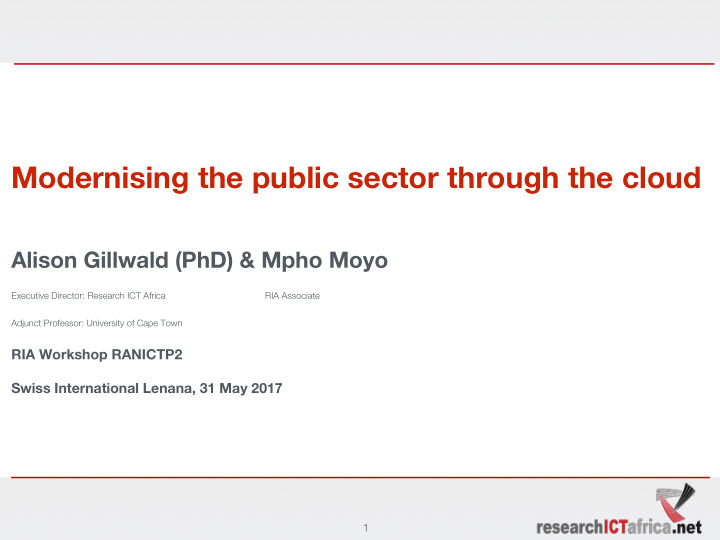



Modernising the public sector through the cloud Alison Gillwald (PhD) & Mpho Moyo Executive Director: Research ICT Africa RIA Associate Adjunct Professor: University of Cape Town RIA Workshop RANICTP2 Swiss International Lenana, 31 May 2017 1
Working definition …ubiquitous …convenient …on-demand …shared configurable resources …rapidly provisioned Cloud Computing …minimal management, effort or service provider interaction 2
Types of cloud Cloud Computing Private Cloud Public Cloud Hybrid Cloud a dedicated resource an open resource open to a mixture of the deployment provided by a cloud service the public models provider for a single client/user SaaS, PaaS, IaaS, Cloud Consulting
Cloud in the ICT Ecosystem Global/regional/Governance ITU, ICANN, WTO National/Industry formations Unions, Industry associations, NGOs Services Integrated perspective of WB, AFDB, International Donors Global player and associations CLOUD Institutional Arrangements Multi-lateral agencies users, markets, networks, Google, Facebook, GSMA Market Structure NRA, CC, USF Affordability (Competitiveness) services, applications & Users Content Apps Consumers Citizens content, determining Access governance, legal and Networks regulatory frameworks Policy & Legal Framework State Constitution 4
Significance of the Cloud 5
Value of cloud computing for the public sector Efficiency at reduced public resources Global standard for IT Generic benefits provision Key in times of stagnating Stimulates e-government Cost Savings economy and reduced government spend 6
The South African Case 7
Context ‣ ICT a key enabler for the achievement of government policies for economic growth and development BUT… ‣ Lack of affordable always on, high-speed and high-quality bandwidth (a key cloud enabler) AND… ‣ With some exceptions, Government has lagged behind the private sector in the strategic deployment of ICT 8
Context (cont…) AND… ‣ The private sector has cautiously adopted cloud computing, while response from government sluggish and uneven (SITA ‘initiative’ may fix this) AND… NO policy or uniform standards to direct the strategic development of cloud computing across the public sector 9
Context RESULTING IN… ‣ Growing frustration amongst government with the inability to deploy cloud services HOWEVER… ‣ Independent government agencies and some of the larger metros not bound by the SITA Act have adopted cloud for non-critical functions 10
Context Supplier driven Privacy and security concerns ICT skills shortage Increased use by private sector Fears of redundancy in human resources early adoption of e-commerce and e- government Slow modernisation of IT by government Gvt. Uses cloud for non-critical processes protracted policy processes and delayed decision-making delaying adoption Disconnect between policy and implementation Government specific 11
Context (cont…) Barriers to cloud adoption in public sector Managerial and Technical barriers Policy challenges organisational barriers Incoherent approaches to Broadband Inadequate frameworks management Vendor selection and Data residency concerns Procurement permissions quality of services Cybersecurity, trust, Privacy and Security Data costs awareness standards and Policy guidelines, No ‘cloud first’ interoperability classification of data 12
SA Cloud Readiness 13
Policy & legal framework ü Strong legal frameworks in place to impact the development and adoption of cloud by the public sector…. û Sector specific laws, institutional arrangements and capacity are weaker, slowing adoption (despite some progress) 14
National Integrated ICT policy Through the NICTP government has identified the following areas key for cloud readiness…. facilitate access to IT resources on-demand without the need for significant capital expenditure…. South Africa has not explored additional capabilities of the Internet that can support more sustainable data management and digitisation…. South Africa will develop initiatives to promote localisation data centres to position South Africa as a data centre hub…. Government will monitor developments in relation to cloud computing to assess the need for specific rules, standards, regulations and/or guidelines on cloud computing Government will embrace innovative ways of using the Internet and may develop relevant standards, policies and regulations relating to Digital Object Architecture… 15
Findings/Conclusions 16
Key findings and conclusions Cloud services is best able to address the business Human resource Funding lumpiness - shift challenges in the public implications/up-skilling from Capex to Opex sector Lack of coherent public Institutional arrangements Fragmentation of mandate policy/ public sector - cohesion in government guidelines Restrictive procurement rules 17
Recommendations 18
Recommendations Improve availability and Create a secure, trusted quality of broadband Position cloud as a environment for the infrastructure (critical solution to capital/skills Internet (e-commerce, e- mass, network effects, shortages government) growth) Develop a cloud Establishing government computing policy Enable shift from Capex working group (SITA framework for public to opex in public sector (DTPS),GITOC, Treasury, sector academia/civil society) Implement and enforce Adopt best practices to Establish a designated open and interoperable develop security champion for cloud standards to public framework for cloud computing services procurement services Expand data Provide guidance for classification guidelines cloud vendor to include cloud certification and computing compliance 19
THANK YOU For full paper go to 20
Recommend
More recommend